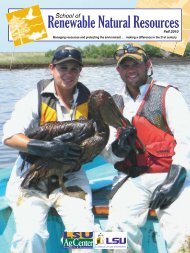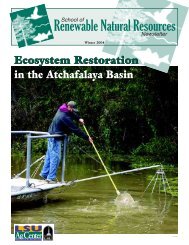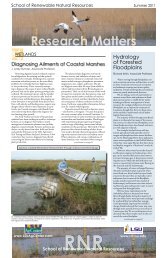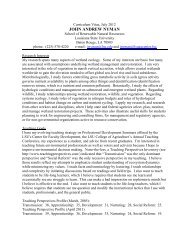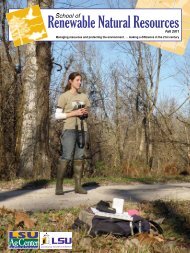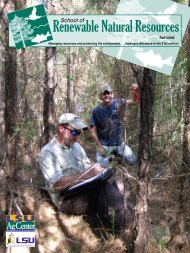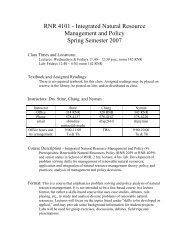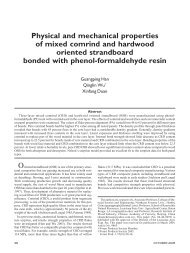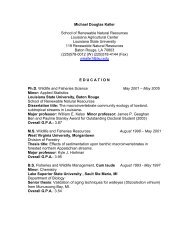Composite Materials Journal of Thermoplastic - LSU School of ...
Composite Materials Journal of Thermoplastic - LSU School of ...
Composite Materials Journal of Thermoplastic - LSU School of ...
Create successful ePaper yourself
Turn your PDF publications into a flip-book with our unique Google optimized e-Paper software.
222 S.-Y. LEE ET AL.<br />
content <strong>of</strong> WF increased. The DT p <strong>of</strong> hybrids with talc was 5–88C lower than<br />
that <strong>of</strong> hybrids without talc. The loading <strong>of</strong> 1 wt% silane to PLA/WF/talc<br />
composites led to a higher thermal decomposition temperature than that <strong>of</strong><br />
3 wt% silane. As WF loading into the PLA increased, the T g <strong>of</strong> the<br />
composites. The addition <strong>of</strong> talc to PLA/WF hybrids also lowered the T g . The<br />
addition <strong>of</strong> WF/talc to neat PLA decreased the T c slightly. The addition <strong>of</strong><br />
1 wt% silane to PLA/WF/talc showed a similar or higher T c compared to that<br />
<strong>of</strong> 3 wt% silane. The application <strong>of</strong> WF, talc, and silane to PLA decreased the<br />
X c <strong>of</strong> composites. The tensile modulus <strong>of</strong> PLA/WF composites was similar or<br />
lower than that <strong>of</strong> neat PLA. The loading <strong>of</strong> talc and 1 wt% silane to<br />
PLA/WF composites improved the tensile modulus. The tensile strength <strong>of</strong><br />
the composites decreased slightly with the addition <strong>of</strong> talc (compared to neat<br />
PLA strength), but it was considerably improved with the use <strong>of</strong> 1 wt% silane.<br />
ACKNOWLEDGMENTS<br />
The authors would like to especially thank Jin-Seong Kim <strong>of</strong> the Korea<br />
University and thank Dr Jong-Bae Lee <strong>of</strong> the Korea Research Institute <strong>of</strong><br />
Chemical Technology for their help with DSC and SEM analysis.<br />
REFERENCES<br />
1. Yang, H.S., Kim, H.J., Park, H.J., Lee, B.J. and Hwang, T.S. (2004). Rice-husk Filled<br />
Polypropylene <strong>Composite</strong>s; Mechanical and Morphological Study, <strong>Composite</strong> Structures,<br />
63: 305–312.<br />
2. Lee, S.Y., Yang, H.S., Kim, H.J., Jeong, C.S., Lim, B.S. and Lee, J.N. (2004). Creep<br />
Behavior and Manufacturing Paramenters <strong>of</strong> Wood Flour Filled Polypropylene<br />
<strong>Composite</strong>s, <strong>Composite</strong> Structures, 65: 459–469.<br />
3. Yu, L., Dean, K. and Li, L. (2006). Polymer Blends and <strong>Composite</strong>s from Renewable<br />
Resources, Progress in Polymer Science, 31: 576–602.<br />
4. Mohanty, A.K., Misra, M. and Hinrichsen, G. (2000). Bi<strong>of</strong>ibers, Biodegradable Polymers<br />
and Biocomposites, An Overview, Macromolecular Material Engineering, 276/277: 1–24.<br />
5. Raya, S.S., Yamada, K., Okamoto, M. and Ueda, K. (2003). New Polylactide-layered<br />
Silicate Nanocomposites. 2. Concurrent Improvements <strong>of</strong> Material Properties,<br />
Biodegradability and Melt Rheology, Polymer, 44: 857–866.<br />
6. Iannace, S., Ali, R. and Nicolais, L. (2001). Biodegradation <strong>of</strong> aliphatic Polyester <strong>Composite</strong>s<br />
Reinforced with Abaca Fiber, <strong>Journal</strong> <strong>of</strong> Applied Polymer Science, 79: 1084–1091.<br />
7. Eichhorn, S.J., Baillie, C.A., Zafeiropoulos, N., Mwaikambo, L.Y., Ansell, M.P. and<br />
Dufresne, A. (2001). Current International Research into Cellulosic Fibres and<br />
<strong>Composite</strong>s, <strong>Journal</strong> <strong>of</strong> Material Science, 36(9): 2107–2131.<br />
8. Mathew, A.P. and Dufresne, A. (2002). Morphological Investigation <strong>of</strong> Nanocomposites<br />
from Sorbitol Plasticized Starch and Tunicin Whiskers, Biomacromolecules, 3: 609–617.<br />
9. Morin, A. and Dufresne, A. (2002). Nanocomposites <strong>of</strong> Chitin Whiskers from Riftia Tubes<br />
and Poly(caprolactone), Macromolecules, 35(6): 2190–2199.<br />
10. Huda, M.S., Drzal, L.T., Mohanty, A.K. and Misra, M. (2006). Chopped<br />
Glass and Recycled Newspaper as Reinforced Fibers in Injection Molded<br />
Downloaded from http://jtc.sagepub.com at KAIST GRADUATE SCHOOL OF MGMT on April 27, 2008<br />
© 2008 SAGE Publications. All rights reserved. Not for commercial use or unauthorized distribution.



